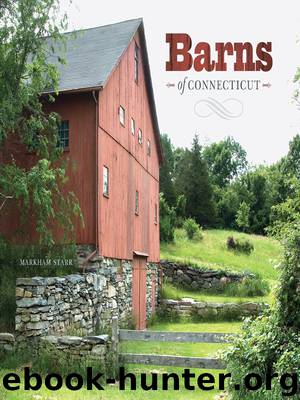Barns of Connecticut by Starr Markham;

Author:Starr, Markham;
Language: eng
Format: epub
Publisher: Wesleyan University Press
Published: 2013-03-13T04:00:00+00:00
Barn raising. City of Toronto Archives, Fonds 1568, Item 177.
As each bent was raised and connected to the previous one, builders checked the structure to ensure it was both plumb and square before the joints were pegged with trunnels. Trunnels, generally an inch to an inch and a quarter in diameter, were made from hardwoods such as oak or black locust and were driven with a large wooden mallet known as a beetle. Carpenters had to bore holes through the timbers they were to fasten with trunnels, a chore unnecessary for iron nails. The primary advantage of a trunnel was that anyone could make them out of materials freely available. In general, the timber frame was connected entirely with joinery and trunnels, and this remained so even after metal fastenings became widely available.
Once the main portion of the barn was assembled up through the plates, builders could begin to raise the roof timbers. If possible, temporary planking was used to give the builders a place from which to work high up on the frame. This temporary planking could have been planks brought to the site for this purpose, or stacks of the material to be used later for roofers and siding. In general, rafters were put up in assembled pairs; once they were braced into vertical position, purlins joining them to the next pair could be installed. If a common rafter system was used, rafter pairs were simply joined to each other with a few boards and nails until they were all standing in position. As with the framing below, rafters were checked to ensure they were square across the building and plumb before the roof was sheathed.
With the rafters raised into position, the sheathing of the building could begin. Early on, with no other choices available to them, carpenters cut planks of wood and nailed them to the exterior of the frame to create the walls of the barn. Roofers, to which the shingles would be nailed, were installed, although unlike the siding below they were spaced apart to allow for air circulation under the shingles. Wooden roof shingles will rot very quickly if not allowed to breathe. While the roofing planks always got this final layer of sheathing, the sidewalls on early barns were most commonly left as planks. These boards expanded in humid weather and shrank in dry weather, allowing — for better or worse — both light and air to circulate freely through the barn.
As time and money allowed, additional siding materials might be added, not only as further protection from the weather but also to help seal cold winter drafts away from both livestock and people working in the barn. At various points in the barn’s evolution, attempts were made to eliminate this free circulation of air. The siding itself could be joined along its vertical edges with either a tongue-and-groove or a ship-lapped joint to cut down on drafts; or the barn siding could be covered over with clapboards, shingles, or a second layer of vertical sheathing covering the seams.
Download
This site does not store any files on its server. We only index and link to content provided by other sites. Please contact the content providers to delete copyright contents if any and email us, we'll remove relevant links or contents immediately.
Shoot Sexy by Ryan Armbrust(17557)
Portrait Mastery in Black & White: Learn the Signature Style of a Legendary Photographer by Tim Kelly(16872)
Adobe Camera Raw For Digital Photographers Only by Rob Sheppard(16797)
Photographically Speaking: A Deeper Look at Creating Stronger Images (Eva Spring's Library) by David duChemin(16498)
Bombshells: Glamour Girls of a Lifetime by Sullivan Steve(13686)
Art Nude Photography Explained: How to Photograph and Understand Great Art Nude Images by Simon Walden(12853)
Perfect Rhythm by Jae(5073)
Pillow Thoughts by Courtney Peppernell(4011)
The Book of Joy by Dalai Lama(3699)
Good by S. Walden(3347)
The Pixar Touch by David A. Price(3210)
A Dictionary of Sociology by Unknown(2857)
Fantastic Beasts: The Crimes of Grindelwald by J. K. Rowling(2844)
Humans of New York by Brandon Stanton(2689)
Stacked Decks by The Rotenberg Collection(2687)
Read This If You Want to Take Great Photographs by Carroll Henry(2602)
On Photography by Susan Sontag(2485)
Photographic Guide to the Birds of Indonesia by Strange Morten;(2407)
Insomniac City by Bill Hayes(2398)
